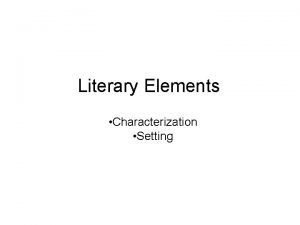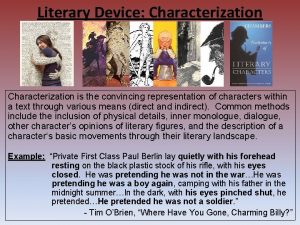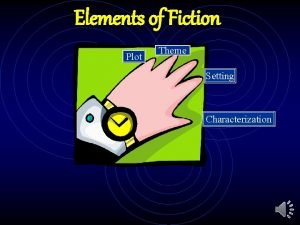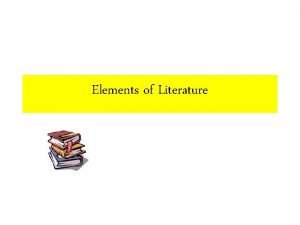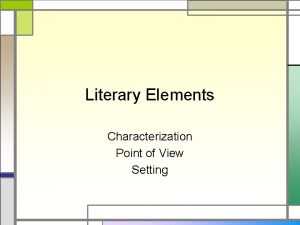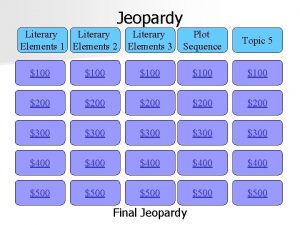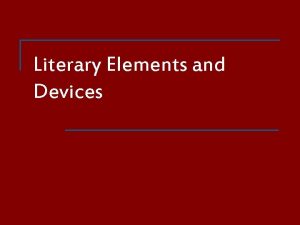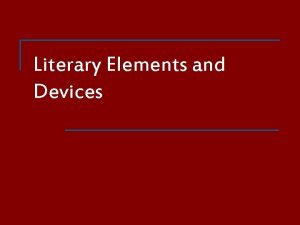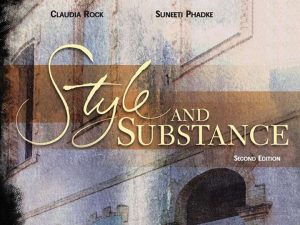Literary Elements Part Two Characterization Setting Setting Setting
















- Slides: 16

+ Literary Elements Part Two: Characterization + Setting

+ Setting

+ Setting n Definition: Describes where and when the story takes place n When = time, where = place n Setting helps build the background of the story and creates images in the mind. n Details can describe: n Time of day, time of year, or time in history n Scenery n Weather n Location

+ Using the Five Senses n. A good setting helps the reader visualize the places in the story. n. A good author includes descriptions of the setting using the five senses… n SIGHT n SMELL n TASTE n FEEL n SOUND

Take a Look…Which is better? The castle was beside the water. OR… The waves crashed loudly against the shoreline. The fog lifted lightly and the medieval castle came into view. It was a beautiful sight! The fog brushed my face, and I could smell the smoke from the fire in the distance and taste the sea salt on my lips.

+ Your Turn… n On the next slide, there is a picture of a setting. n In your own words, write a detailed description of the setting in your picture. Include many adjectives and don’t forget to include descriptions for each of the five senses: see, hear, feel, smell, taste


+ Characterization

+ Every story needs characters People Animals Creatures

The protagonist is the “good guy” Usually, the protagonist is the main character of the story.

+ The antagonist is the “bad guy” or force

+ Characterization n Characterization is the way in which an author shows the personality of a character n Characterization is a technique writers use to make characters “come to life. ” n An author can tell you about a character’s personality and traits in two ways: n Directly n Indirectly

+ Character Traits are descriptive adjectives that tell us specific qualities of a character • Honest • Light-hearted • Leader • Expert • Brave • Conceited • Mischievous • Demanding • Thoughtful • Keen • Happy • Disagreeable • Simple • Fancy • Plain • Excited • Studious • Inventive • Creative • Thrilling • Independent • Intelligent • Compassionate • Gentle • Proud • Wild • Messy • Neat • Joyful • Strong • Bright • Courageous • Serious • Funny • Humorous • Sad • Poor • Rich • Tall • Dark • Light • Handsome • Pretty • Ugly • Selfish • Unselfish • Self-confident • Respectful • Considerate • Imaginative • Busy • Patriotic • Fun-loving • Popular • Successful • Responsible • Lazy • Dreamer • Helpful • Simpleminded • Humble • Friendly • Short • Adventurous • Hard-working • Timid • Shy • Bold • Daring • Dainty • Pitiful • Cooperative • Lovable • Prim • Proper • Ambitious • Able • Quiet • Curious • Reserved • Pleasing • Bossy • Witty • Fighter • Tireless • Energetic • Cheerful • Smart • Impulsive • Loyal

+ Direct Characterization n Direct characterization is obvious and spelled out. The author tells you exactly what they want you to know about the character’s personality. You don’t have to guess. n Example: n What “Freddy was very competitive. ” character trait does the author tell us Freddy has?

+ Indirect Characterization n Indirect characterization tells us something about the character, but it is not as obvious. Instead of just telling us what traits the character has, the author shows us. n The author can reveal character traits by the character’s speech, thought, effect on others, actions, or looks. n You have to be a bit of a detective to find out the character’s traits. n Example: “Two days before the game, Freddy gathered his teammates and laid out his game plan. Then, he looked at them and said, “We are going to win this game! No excuses!” n What character trait does the author show us that Freddy has?

+ Character Motivation n Character Motivation is the driving force behind why the character does what he/she does. (Reasons for character’s actions) n What does the main character want more than anything else (main goal)? n What do secondary characters want more than anything else (main goal)? n What potential conflicts or struggles might exist between the characters?
 Elements of characterization
Elements of characterization Literary elements characterization
Literary elements characterization Literary devices techniques
Literary devices techniques Direct and indirect characterization definition
Direct and indirect characterization definition Indirect and direct characterization
Indirect and direct characterization Setting literary definition
Setting literary definition Direct characterization example
Direct characterization example Harrison bergeron foreshadowing
Harrison bergeron foreshadowing Setting literary device
Setting literary device Where have you gone charming billy essay
Where have you gone charming billy essay Literary elements techniques
Literary elements techniques Theme setting plot
Theme setting plot Elements of characterization
Elements of characterization Part part whole addition
Part part whole addition Part to part ratio definition
Part to part ratio definition Part part whole
Part part whole What is a technical description?
What is a technical description?
